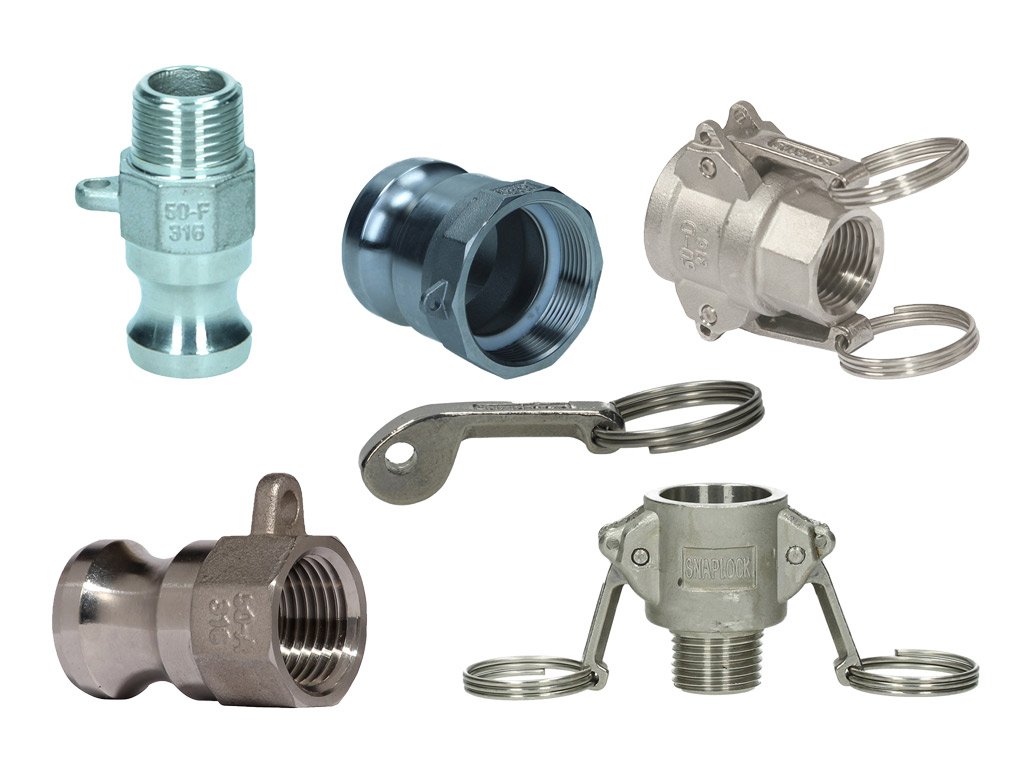Polypropylene Vs. PVC Camlock Fittings: What are the Differences?
The assembly of the Camlock fittings comprises a female coupler and a male groove adapter. For connecting and disconnecting the Camlock fittings, the handle on the coupler is extended outward, and a correct-sized male adapter fits in the female coupler. When both halves are tightly attached, handles are closed. Simultaneously closing both handles makes sure that the grooved adapter is pulled down onto the seal, which then ensures the passing of contamination from one pipe to the other. But be sure that assembly is depressurized.

Camlock fittings can be categorized based on their material, dimensions, and shapes. However, the primary function of all the Camlock fittings is to connect and disconnect the pipes and hoses to ease the flow of fluid within them. While talking about materials, the Camlock fittings can be made of PVC or polypropylene, depending upon the environment and nature of the job.
So, in this article, we will compare PVC Camlock fittings and Polypropylene Camlock fittings. Let’s find out below.
What is Polypropylene Camlock and Its Features?
Polypropylene is a type of plastic raw material used in manufacturing polypropylene Camlock fittings. When it comes to the polypropylene Camlock fittings manufactured by Union Metal, they are made complying with the standards enshrined in A-A-59326, and the size ranges from 1/2 inches to 4 inches. The black-colored polypropylene Camlock fittings are combined with fiberglass with acid resistance of around 25% to 30%.
Here are some of the distinctive characteristics of polypropylene Camlock fittings:
- Resistance Against Corrosion and Chemical
The main benefit of using polypropylene Camlock fittings is that they are free from corrosion. They can also endure any effect from acids, bases, wastewater, solvents, and fertilizers. It is what makes these Camlock fittings perfect for industrial or agriculture applications.
- Cost-Effective and Light in Weight
Polypropylene Camlock fittings are convenient and suitable for light industries, including agriculture, irrigation, paint, municipal, and sewage. Their use is preferred due to their cost effectiveness for mega-projects and lower weight. Although the weight is down, still the strength of these fittings is admirable. Moreover, they connect and disconnect without using tools.
- High Durability
When used in the light industries, the durability of these fittings is matchless. Despite being a plastic material component, it still has a vast capacity to withstand pressure and temperature. If used properly, the life and durability of these Camlock fittings are impressive.
What is PVC Camlock and Its Features?
Like the polypropylene Camlock fittings, PVC Camlock fittings also have applications in several industries. PVC is also a type of plastic raw material. Nevertheless, the overwhelming qualities of this material make it the perfect choice to be used in different industries. Here are some of its essential features:
- Safe and Light in Weight
PVC (polyvinyl chloride) Camlock fittings are non-toxic if not burned. They exhibit environment-friendly behavior. Being the most tested plastic material globally, it meets all the standards for health and safety. The lightweight and protection offered by this material bring it to be used as a perfect coupling in different industries such as the chemical, oil, and gas industries.
- Strong Against Physical Impacts
The PVC Camlock fittings are massively used to ensure the safe transfer of fluid within the pipes. The material is dense and opposes impact deformation compared to different plastics. Its good mechanical strength and hardness enable fittings to be used as a coupling on the construction sites.
- Endurance and Durability
The PVC Camlock fittings are made up of plastic. Still, the impact resistance, hardness, and tensile strength of this material are enough to sustain stresses. As a result, their durability is usually high.
Differences Of Polypropylene and PVC Camlock
Both PVC Camlock fittings and polypropylene fittings are high in demand because of their effectiveness. They have numerous applications in their respective industries. Furthermore, both have their benefits, and most of them might overlap each other.
- Polypropylene Camlock fittings are the most impartial plastic fittings, comprising only two elements: carbon and hydrogen. In comparison, PVC Camlock fittings have about 30% of chlorine in their fundamental structure. And we know that chlorine is a hazardous substance in the environment.
- When incinerated, PVC produces dioxins, hydrochloric acid, and chlorocarbons. These byproducts are toxic. On the other hand, the complete combustion of polypropylene will give only water and carbon dioxide.
- PVC fittings are vulnerable to heat. Conversely, polypropylene fittings are significantly more tolerant to heat.
- PVC Camlock fittings might be more rigid and more brittle. In contrast, polypropylene Camlock fittings are flexible and rigid.
- Polypropylene is resistant to attack by any solvent, while PVC can be broken up or dissolved by solvents.
Conclusion
Union Metal is a leading company that deals in manufacturing top-notch, customized, and reasonably priced PVC Camlock fittings and polypropylene Camlock fittings. Autonomous departments rigorously regulate all production measures and processes, focusing on optimizing production efficiency and quality levels. Thus, if you are looking for an experienced Camlock fittings supplier, Union Metal will always be at your service.


